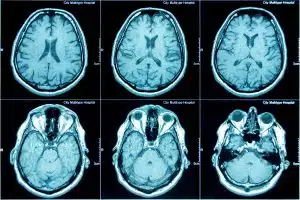A Closer Look: Interview with APDA Researchers
Our A Closer Look blog is designed to educate, inform, and inspire you through a variety of topics and insights about Parkinson’s disease (PD). One way we do that is through our Interview with APDA Researchers series within this blog so you can get a closer look at some of the dedicated APDA-funded researchers who are working tirelessly to understand this disease.
Meet Dr. Stephan Grimaldi
Recipient of a 2023 post-Doctoral fellowship from APDA
Today we introduce you to Dr. Stephan Grimaldi, a post-doctoral fellow at Massachusetts General Hospital and recipient of a 2023 post-Doctoral fellowship from APDA. He is currently researching ways to use the cutting-edge technology of a 7-Tesla MRI scanner to evaluate brain biomarkers of neurodegeneration in the stage prior to the development of Parkinson’s disease. Through his research he aims to identify biomarkers of neurodegeneration with the goal of making early diagnosis a reality. Identifying PD biomarkers is incredibly important because early identification of those who will develop PD allows these individuals to be at the forefront of clinical trials for prevention of progression.
Thank you to Nicole Hill, RN, a health and wellness content writer, and avid APDA Northwest Chapter volunteer, who interviewed Dr. Grimaldi for this article. Excerpts of her conversation are showcased here, and a version of this article also appeared in the Northwest Chapter’s quarterly newsletter, Pathfinder.
Q: Could you describe your research?
A: I’m very interested in finding out what’s happening in the brains of people who get PD. A lot of studies and research focus on people who already have the motor symptoms of Parkinson’s disease. By that time, over 50% of the dopamine neurons are dead. So, we must focus on the 10-15 years before motor symptoms of the disease appear. But how do we identify which people are going to develop PD in the future? We know that REM sleep behavior disorder (RBD), a sleep disturbance in which people act out their dreams, can occur in people prior to a diagnosis of PD. Over 70% of people with RBD will go on to develop PD. We would therefore like to know what is going on in the brains of people with RBD and potentially find biomarkers of neural degeneration. If we can do this, we can propose new treatments and then follow the effect of the treatments by looking at those biomarkers. Since these individuals do not have motor symptoms of PD, we cannot follow their clinical state, so biomarkers that can be followed over time are very critical for this population.
Q: What methods do you use to conduct your research?
A: We first must identify people with RBD who do not have a diagnosis of PD. Those people are actually hard to find for our research because patients who have RBD symptoms do not generally see a doctor. Some of them sleep alone so they do not even know they are acting out their dreams, and some of them are told by their partner that they are active sleepers, but they do not go to see a doctor. When we do identify such a patient, they are seen by a neurologist at the sleep clinic and then can be referred for the study.
During the study, we perform several clinical scales for PD even if they do not have the symptoms. After that, they go into the 7-Tesla MRI scanner (a standard MRI is 3-Tesla), which produces images of the brain that are very precise and can discern microstructure, anatomy, and connectivity from one part of the brain to another. My project is to analyze both baseline MRI and follow-up MRI to see the changes concerning microstructure, anatomic changes, and connectivity changes in the part of the brain where we know there are nuclei that are involved in the sleep process. We hypothesize that those nuclei in the brain stem and the connectivity between them are damaged.
Q: What do you hope to accomplish with your research?
A: We are hoping to be able to identify an early change that can serve as a biomarker for neuronal loss. The biomarker could then be monitored. For example, if we give a treatment, we will be able to see if this treatment is effective or not by following what happens to the biomarker. There are several treatments in clinical trial that target the alpha-synuclein protein which aggregates in PD. Currently, these clinical trials are recruiting people with PD and not RBD alone, but in the future, clinical trials might expand to include people with RBD to see if onset of PD might be delayed or even prevented. The goal would therefore be to monitor the brain changes in the MRI biomarkers we develop as the treatment is given.
Q: What’s the advantage of an earlier diagnosis?
A: Knowing that you have PD, or that you are at very high risk of developing PD, will potentially allow you access to clinical trials that aim to delay or prevent disease progression. In addition, knowing your PD diagnosis can be motivating to make healthy lifestyle changes such as increased exercise and improved diet which can have a substantial impact on brain health.
Q: How might your research benefit people who already have PD?
A: There are other reasons to conduct research into the microstructure, anatomy, and connectivity of the brain besides the identification of an early biomarker of neurodegeneration. For example, in people who already have PD, this knowledge can more precisely guide electrode placement during a deep brain stimulation (DBS) surgery. Understanding these structural changes in someone who has PD can even help in the design of new DBS strategies.
Q: Why did you choose to focus your research on PD?
A: I chose PD because I’m very interested in the multiple symptoms of PD; the motor symptoms and the non-motor symptoms – particularly the neuropsychiatric symptoms, such as RBD – throughout the course of the disease. My research is motivated by the idea that we can do something – we can find a way to stop the evolution of the disease. I really want to be part of what we can discover early in the disease to change people’s lives.
Tips and Takeaways
- Dr. Stephan Grimaldi, an APDA-funded researcher, is studying the use of 7-Tesla MRI to evaluate brain biomarkers of neurodegeneration that appear before development of motor symptoms of PD.
- Identifying early PD biomarkers is incredibly important because early identification of those who will develop PD allows these individuals to be at the forefront of clinical trials for prevention of progression of disease.
- You can learn more about Dr. Grimaldi’s work, as well as all of the researchers APDA is currently funding, in the What We Fund section of our website.
- You can also read past interviews with other APDA-funded researchers including Dr. Abby Olsen, Dr. April Darling, and Dr. Edward Griffin, and enjoy a “Where Are They Now” look at some past APDA-funded researchers.
- APDA is able to fund researchers like Dr. Grimaldi because of the generous donations we receive from dedicated people like you. If you would like to support critical work like this, please consider making a donation of any size today. Thank you.


